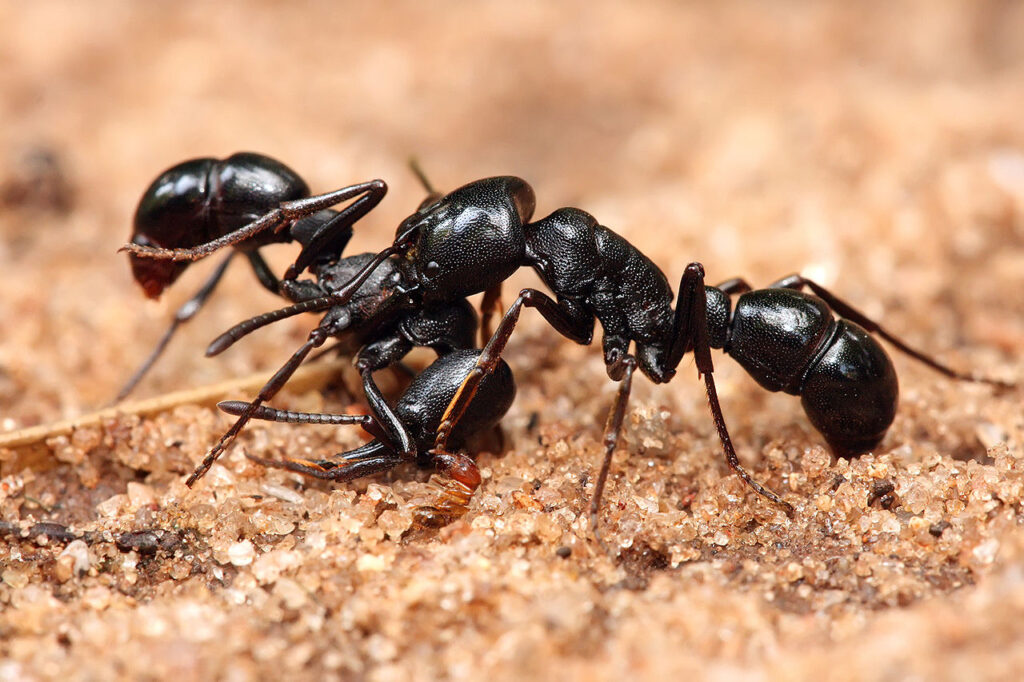
Ants are among the most successful species on Earth, thriving in a wide range of climates and environments. Their communal nature, division of labor, and adaptability significantly contribute to their widespread success. However, without effective ant control, these infestations can quickly disrupt homes and businesses. Here’s an in-depth look at their biology, anatomy, and behavior to help you understand how to prevent and eliminate ant infestations.
Ant Control Overview: Understanding Ants
Ants belong to the order Hymenoptera, which also includes bees and wasps. You can find ants in almost every habitat on Earth, from the tropics to the arctic, and from deserts to moist regions. Their ability to adapt to diverse environments and their complex social structure play key roles in their success. Ants also undergo complete metamorphosis throughout their life cycle, making them resilient pests.
Anatomy of Ants for Effective Ant Control
Size and Color
- Size: Ants vary greatly in size. The largest ant, Dorylus wilverthi female, can reach up to 4 cm, while the smallest ant is just 0.8 mm long.
- Color: They come in various colors—black, brown, yellow, red, or a combination of these.
Antennae
- Function: Ants have elbowed antennae that serve as their primary sensory organs for touch and smell.
- Structure: The antenna consists of a scape and a funiculus (whip). Loss of antennae severely limits an ant’s ability to interact with its environment.
- Smell: Ants have a unique sense of smell, allowing them to identify objects by shape, texture, and even direction.
Head
The head houses the mandibles, which are used for biting, building, carrying, and cutting, but not for eating.
Legs
Ants use their legs, particularly the forelegs, for grooming. Spurs on their legs help remove dust and other debris. The tarsal glands secrete a lubricant that aids in this cleaning process.
Ant Biology and Habits: Essential for Ant Control
Ants follow a distinct life cycle: egg → larva → pupa → adult. The entire process can take anywhere from 6 weeks to 2 months, depending on the species and environmental conditions.
Life Stages
- Egg: The egg is microscopic in size.
- Larva: A soft, legless larva hatches from the egg and goes through several molts before becoming a pupa.
- Pupa: In some species, the pupa is enclosed in a cocoon, while in others, the pupa is “naked.” This stage is often confused with ant eggs.
- Adult: After emerging from the pupa, the adult ant takes a few days to fully mature.
Ant Colonies and Castes for Better Ant Control
Ants live in highly organized colonies with a division of labor among different castes: workers, males, and queens.
Establishment of an Ant Colony
- Queen: A newly mated queen loses her wings and finds a suitable place to lay her eggs. She remains in the cell, feeding the larvae with her saliva until they pupate.
- First Workers: The first workers that emerge are abnormally small due to limited resources but will later grow larger as the colony thrives.
The Worker
Workers are sterile females and perform tasks such as nest building, foraging for food, and caring for the queen and young. They may live up to seven years.
The Male
Males are winged and die shortly after mating with the queen during the nuptial flight. They have larger eyes and powerful wing muscles.
The Queen
The queen is the largest ant in the colony and is solely responsible for reproduction. She mates only once but can produce offspring for many years.
Feeding Habits of Ants
Ants are omnivores, feeding on a variety of foods but primarily preferring greasy, starchy, and sweet substances. Their sense of smell, which is highly developed, helps them locate food. Ants use pheromones to communicate with other colony members, laying down scent trails to guide others to food sources.
Common Foods
- Sugars: Ants are liquid-sugar feeders and obtain nourishment from plant nectar and insect honeydew.
- Pheromone Trails: Once a food source is found, ants lay down a pheromone trail for others to follow.
Key Takeaways for Ant Control
Ant Types and Control Methods
| Ant Species | Size | Common Food Sources | Preferred Nesting Sites | Control Methods |
|---|---|---|---|---|
| Argentine Ant | Small | Sugary foods | Moist areas near buildings | Bait stations, exclusion |
| Carpenter Ant | Large | Protein, wood damage | Inside wood structures | Insecticidal sprays, sealing |
| Fire Ant | Medium | Greasy, protein-rich | Mounds in open areas | Bait, mound treatments |
| Harvester Ant | Medium | Seeds, small insects | Open, sandy soil or fields | Bait, mound treatments, perimeter sprays |
| Odorous House Ant | Small | Sugary foods, protein | Indoors, near food sources | Baiting, exclusion |
| Pharaoh Ant | Small | Sugars, proteins | Indoors, near food sources | Baiting, exclusion |
| Pavement Ant | Medium | Sugary foods, seeds | Under pavement, near buildings | Bait, insecticidal sprays |
| Thief Ant | Small | Grease, protein | Indoors, in walls, or under floors | Baiting, sealing |
| Velvety Tree Ant | Medium | Sugars, honeydew | Under tree bark, soil, wood | Soil treatment, tree banding |
Prevention Tips
- Seal Entry Points: Ants can enter homes through the tiniest cracks. Seal any potential entry points.
- Eliminate Food Sources: Keep food sealed and clean up spills promptly.
- Use Bait Stations: Baits are effective as they attract ants to carry poison back to their colony.
This detailed overview of ants, their biology, and control measures can help clients understand how to manage ant infestations effectively.
Struggling with ants in your home or business? Our expert team at Traffic Pest Solutions offers effective and reliable ant control services to keep your property pest-free. Learn more about our pest control services and schedule your free consultation today!
For more information on managing ants in your home, visit the UC California IPM Program.
